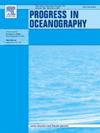Surface CO2 partial pressure and air–sea CO2 flux on the China side of the South Yellow Sea based on multiple-year underway measurements during 2005–2011 and comparison with results for 2011–2018
IF 3.6
3区 地球科学
Q1 OCEANOGRAPHY
引用次数: 0
Abstract
By resolving spatiotemporal variations in sea surface partial pressure of CO2 (pCO2) based on multiple-year underway measurements, we quantified basin-scale air–sea CO2 exchange flux on the China side of the South Yellow Sea between 2005 and 2011, and compared it with the result obtained between 2011 and 2018. Over the three subregions under study, the area-weighted average of the CO2 influx rate was estimated to be 1.1 ± 1.5 mol m−2 yr−1 during 2005–2011, which is only half the annual CO2 influx rate over the adjacent East China Sea shelf but not remarkably different from the rate (0.4 ± 2.1 mol m−2 yr−1) estimated for almost the same sea area during 2011–2018. Over central and western parts of the South Yellow Sea, subregion-specific fitting curves of monthly variations in air–sea CO2 flux during 2005–2011 were consistent with those monthly variations during 2011–2018. However, over the southern part of the South Yellow Sea near the Changjiang Estuary, the fitting curve of monthly variations in air–sea CO2 fluxes during 2005–2011 located systematically on one side of the monthly variation estimated for 2011–2018, indicating that annual CO2 uptake had weakened in this subregion. Both cases were different from some other ocean margin areas characterized by enhanced CO2 uptake following rise in atmospheric CO2. To study the potential shift in terms of shelf CO2 sources and sinks over multiple decades and under environmental changes, further field observations and data-based research are needed on several large continental shelves.
基于2005-2011年多年测量数据并与2011-2018年结果比较的南黄海中国侧地表CO2分压和海气CO2通量
通过解析基于多年水下测量的海面二氧化碳分压(pCO2)的时空变化,我们量化了2005-2011年间南黄海中国一侧海盆尺度的海气二氧化碳交换通量,并与2011-2018年间的结果进行了比较。在所研究的三个次区域中,2005-2011 年间二氧化碳流入率的区域加权平均值估计为 1.1 ± 1.5 摩尔 m-2 yr-1,仅为邻近东海大陆架二氧化碳年流入率的一半,但与 2011-2018 年间几乎相同海域的估计值(0.4 ± 2.1 摩尔 m-2 yr-1)相差不大。在南黄海中部和西部海域,2005-2011年期间海气二氧化碳通量月变化的分区域拟合曲线与2011-2018年期间的月变化曲线一致。然而,在南黄海南部靠近长江口的海域,2005-2011 年期间海气二氧化碳通量月变化拟合曲线系统地位于 2011-2018 年期间估计月变化的一侧,表明该次区域的二氧化碳年吸收量有所减弱。这两种情况都不同于其他一些海洋边缘地区,其特点是大气二氧化碳上升后二氧化碳吸收增强。为了研究几十年来大陆架二氧化碳源和汇在环境变化下的潜在变化,需要对几个大型大陆架进行进一步的实地观测和基于数据的研究。
本文章由计算机程序翻译,如有差异,请以英文原文为准。
求助全文
约1分钟内获得全文
求助全文
来源期刊

Progress in Oceanography
地学-海洋学
CiteScore
7.20
自引率
4.90%
发文量
138
审稿时长
3 months
期刊介绍:
Progress in Oceanography publishes the longer, more comprehensive papers that most oceanographers feel are necessary, on occasion, to do justice to their work. Contributions are generally either a review of an aspect of oceanography or a treatise on an expanding oceanographic subject. The articles cover the entire spectrum of disciplines within the science of oceanography. Occasionally volumes are devoted to collections of papers and conference proceedings of exceptional interest. Essential reading for all oceanographers.
 求助内容:
求助内容: 应助结果提醒方式:
应助结果提醒方式:


